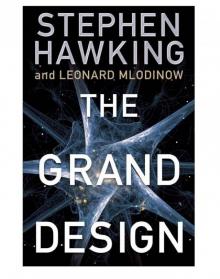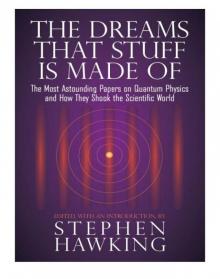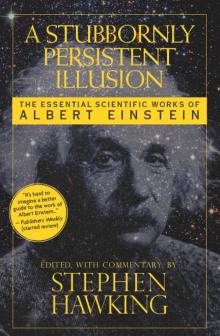- Home
- Stephen Hawking
A Stubbornly Persistent Illusion Page 24
A Stubbornly Persistent Illusion Read online
Page 24
I must not fail to mention that a theoretical argument can be adduced in favour of the hypothesis of a finite universe. The general theory of relativity teaches that the inertia of a given body is greater as there are more ponderable masses in proximity to it; thus it seems very natural to reduce the total effect of inertia of a body to action and reaction between it and the other bodies in the universe, as indeed, ever since Newton’s time, gravity has been completely reduced to action and reaction between bodies. From the equations of the general theory of relativity it can be deduced that this total reduction of inertia to reciprocal action between masses—as required by E. Mach, for example—is possible only if the universe is spatially finite.
On many physicists and astronomers this argument makes no impression. Experience alone can finally decide which of the two possibilities is realised in nature. How can experience furnish an answer? At first it might seem possible to determine the mean density of matter by observation of that part of the universe which is accessible to our perception. This hope is illusory. The distribution of the visible stars is extremely irregular, so that we on no account may venture to set down the mean density of star-matter in the universe as equal, let us say, to the mean density in the Milky Way. In any case, however great the space examined may be, we could not feel convinced that there were no more stars beyond that space. So it seems impossible to estimate the mean density. But there is another road, which seems to me more practicable, although it also presents great difficulties. For if we inquire into the deviations shown by the consequences of the general theory of relativity which are accessible to experience, when these are compared with the consequences of the Newtonian theory, we first of all find a deviation which shows itself in close proximity to gravitating mass, and has been confirmed in the case of the planet Mercury. But if the universe is spatially finite there is a second deviation from the Newtonian theory, which, in the language of the Newtonian theory, may be expressed thus:—The gravitational field is in its nature such as if it were produced, not only by the ponderable masses, but also by a mass-density of negative sign, distributed uniformly throughout space. Since this factitious mass-density would have to be enormously small, it could make its presence felt only in gravitating systems of very great extent.
Assuming that we know, let us say, the statistical distribution of the stars in the Milky Way, as well as their masses, then by Newton’s law we can calculate the gravitational field and the mean velocities which the stars must have, so that the Milky Way should not collapse under the mutual attraction of its stars, but should maintain its actual extent. Now if the actual velocities of the stars, which can, of course, be measured, were smaller than the calculated velocities, we should have a proof that the actual attractions at great distances are smaller than by Newton’s law. From such a deviation it could be proved indirectly that the universe is finite. It would even be possible to estimate its spatial magnitude.
Can we picture to ourselves a three-dimensional universe which is finite, yet unbounded?
The usual answer to this question is “No,” but that is not the right answer. The purpose of the following remarks is to show that the answer should be “Yes.” I want to show that without any extraordinary difficulty we can illustrate the theory of a finite universe by means of a mental image to which, with some practice, we shall soon grow accustomed.
First of all, an obervation of epistemological nature. A geometrical-physical theory as such is incapable of being directly pictured, being merely a system of concepts. But these concepts serve the purpose of bringing a multiplicity of real or imaginary sensory experiences into connection in the mind. To “visualise” a theory, or bring it home to one’s mind, therefore means to give a representation to that abundance of experiences for which the theory supplies the schematic arrangement. In the present case we have to ask ourselves how we can represent that relation of solid bodies with respect to their reciprocal disposition (contact) which corresponds to the theory of a finite universe. There is really nothing new in what I have to say about this; but innumerable questions addressed to me prove that the requirements of those who thirst for knowledge of these matters have not yet been completely satisfied.
So, will the initiated please pardon me, if part of what I shall bring forward has long been known?
What do we wish to express when we say that our space is infinite? Nothing more than that we might lay any number whatever of bodies of equal sizes side by side without ever filling space. Suppose that we are provided with a great many wooden cubes all of the same size. In accordance with Euclidean geometry we can place them above, beside, and behind one another so as to fill a part of space of any dimensions; but this construction would never be finished; we could go on adding more and more cubes without ever finding that there was no more room. That is what we wish to express when we say that space is infinite. It would be better to say that space is infinite in relation to practically-rigid bodies, assuming that the laws of disposition for these bodies are given by Euclidean geometry.
Another example of an infinite continuum is the plane. On a plane surface we may lay squares of cardboard so that each side of any square has the side of another square adjacent to it. The construction is never finished; we can always go on laying squares—if their laws of disposition correspond to those of plane figures of Euclidean geometry. The plane is therefore infinite in relation to the cardboard squares. Accordingly we say that the plane is an infinite continuum of two dimensions, and space an infinite continuum of three dimensions. What is here meant by the number of dimensions, I think I may assume to be known.
Now we take an example of a two-dimensional continuum which is finite, but unbounded. We imagine the surface of a large globe and a quantity of small paper discs, all of the same size. We place one of the discs anywhere on the surface of the globe. If we move the disc about, anywhere we like, on the surface of the globe, we do not come upon a limit or boundary anywhere on the journey. Therefore we say that the spherical surface of the globe is an unbounded continuum. Moreover, the spherical surface is a finite continuum. For if we stick the paper discs on the globe, so that no disc overlaps another, the surface of the globe will finally become so full that there is no room for another disc. This simply means that the spherical surface of the globe is finite in relation to the paper discs. Further, the spherical surface is a non-Euclidean continuum of two dimensions, that is to say, the laws of disposition for the rigid figures lying in it do not agree with those of the Euclidean plane. This can be shown in the following way. Place a paper disc on the spherical surface, and around it in a circle place six more discs, each of which is to be surrounded in turn by six discs, and so on. If this construction is made on a plane surface, we have an uninterrupted disposition in which there are six discs touching every disc except those which lie on the outside.
On the spherical surface the construction also seems to promise success at the outset, and the smaller the radius of the disc in proportion to that of the sphere, the more promising it seems. But as the construction progresses it becomes more and more patent that the disposition of the discs in the manner indicated, without interruption, is not possible, as it should be possible by Euclidean geometry of the the plane surface. In this way creatures which cannot leave the spherical surface, and cannot even peep out from the spherical surface into three-dimensional space, might discover, merely by experimenting with discs, that their two-dimensional “space” is not Euclidean, but spherical space.
From the latest results of the theory of relativity it is probable that our three-dimensional space is also approximately spherical, that is, that the laws of disposition of rigid bodies in it are not given by Euclidean geometry, but approximately by spherical geometry, if only we consider parts of space which are sufficiently great. Now this is the place where the reader’s imagination boggles. “Nobody can imagine this thing,” he cries indignantly. “It can be said, but cannot be thought. I can represent to myself a spherical s
urface well enough, but nothing analogous to it in three dimensions.”
We must try to surmount this barrier in the mind, and the patient reader will see that it is by no means a particularly difficult task. For this purpose we will first give our attention once more to the geometry of two-dimensional spherical surfaces. In the adjoining figure let K be the spherical surface, touched at S by a plane, E, which, for facility of presentation, is shown in the drawing as a bounded surface. Let L be a disc on the spherical surface. Now let us imagine that at the point N of the spherical surface, diametrically opposite to S, there is a luminous point, throwing a shadow L′ of the disc L upon the plane E. Every point on the sphere has its shadow on the plane. If the disc on the sphere K is moved, its shadow L′ on the plane E also moves. When the disc L is at S, it almost exactly coincides with its shadow. If it moves on the spherical surface away from S upwards, the disc shadow L′ on the plane also moves away from S on the plane outwards, growing bigger and bigger. As the disc L approaches the luminous point N, the shadow moves off to infinity, and becomes infinitely great.
Now we put the question. What are the laws of disposition of the disc-shadows L′ on the plane E? Evidently they are exactly the same as the laws of disposition of the discs L on the spherical surface. For to each original figure on K there is a corresponding shadow figure on E. If two discs on K are touching, their shadows on E also touch. The shadow-geometry on the plane agrees with the the disc-geometry on the sphere. If we call the disc-shadows rigid figures, then spherical geometry holds good on the plane E with respect to these rigid figures. Moreover, the plane is finite with respect to the disc-shadows, since only a finite number of the shadows can find room on the plane.
At this point somebody will say, “That is nonsense. The disc-shadows are not rigid figures. We have only to move a two-foot rule about on the plane E to convince ourselves that the shadows constantly increase in size as they move away from S on the plane towards infinity.” But what if the two-foot rule were to behave on the plane E in the same way as the disc-shadows L′? It would then be impossible to show that the shadows increase in size as they move away from S; such an assertion would then no longer have any meaning whatever. In fact the only objective assertion that can be made about the disc-shadows is just this, that they are related in exactly the same way as are the rigid discs on the spherical surface in the sense of Euclidean geometry.
We must carefully bear in mind that our statement as to the growth of the disc-shadows, as they move away from S towards infinity, has in itself no objective meaning, as long as we are unable to employ Euclidean rigid bodies which can be moved about on the plane E for the purpose of comparing the size of the disc-shadows. In respect of the laws of disposition of the shadows L′, the point S has no special privileges on the plane any more than on the spherical surface.
The representation given above of spherical geometry on the plane is important for us, because it readily allows itself to be transferred to the three-dimensional case.
Let us imagine a point S of our space, and a great number of small spheres, L′, which can all be brought to coincide with one another. But these spheres are not to be rigid in the sense of Euclidean geometry; their radius is to increase (in the sense of Euclidean geometry) when they are moved away from S towards infinity, and this increase is to take place in exact accordance with the same law as applies to the increase of the radii of the disc-shadows L′ on the plane.
After having gained a vivid mental image of the geometrical behaviour of our L′ spheres, let us assume that in our space there are no rigid bodies at all in the sense of Euclidean geometry, but only bodies having the behaviour of our L′ spheres. Then we shall have a vivid representation of three-dimensional spherical space, or, rather of three-dimensional spherical geometry. Here our spheres must be called “rigid” spheres. Their increase in size as they depart from S is not to be detected by measuring with measuring-rods, any more than in the case of the disc-shadows on E, because the standards of measurement behave in the same way as the spheres. Space is homogeneous, that is to say, the same spherical configurations are possible in the environment of all points.* Our space is finite, because, in consequence of the “growth” of the spheres, only a finite number of them can find room in space.
* This is intelligible without calculation—but only for the two-dimensional case—if we revert once more to the case of the disc on the surface of the sphere.
In this way, by using as stepping-stones the practice in thinking and visualisation which Euclidean geometry gives us, we have acquired a mental picture of spherical geometry. We may without difficulty impart more depth and vigour to these ideas by carrying out special imaginary constructions. Nor would it be difficult to represent the case of what is called elliptical geometry in an analogous manner. My only aim to-day has been to show that the human faculty of visualisation is by no means bound to capitulate to non-Euclidean geometry.
Selections from
The Meaning of Relativity
Three hundred years before Einstein, Galileo Galilei developed a theory of relativity that ultimately formed one of the pillars of Sir Isaac Newton’s mechanics. In The Meaning of Relativity, Einstein presents Galilean relativity as a precursor not only to Newton’s work, but to his own as well.
Galilean relativity is based on the simple and intuitive idea that time flows constantly for all observers regardless of their state of motion. Galileo thus anticipated Newton’s first law of motion: objects in motion will maintain a constant speed and direction unless acted upon by an outside force.
For all of the apparent mathematical complexity in The Meaning of Relativity, Einstein’s goals are quite modest. He is simply demonstrating that measurements on either stationary or moving frames will both yield results that satisfy Newton’s laws of motion. He proceeds to show at the end of the chapter that a different set of transformations, those suggested by Hendrik Lorentz, are required to make Maxwell’s equations of electricity and magnetism work in moving frames of reference.
The difference between Galileo’s transformations and those of Lorentz is that the former result in a constant flow of time for all observers, while the latter yield different rates of time for observers in different states of motion.
But what do we mean by a “constant flow of time”? It is simple to say that one event precedes another, or that they occur simultaneously, but how do we measure time, except through time itself? Einstein suggests using the reflection of an emitted light beam as a clock, postulating that light travels at the same speed regardless of the state of motion of an observer. This simple thought experiment yields some very surprising results.
For example, he finds that an observer measuring the events in a train moving past him will see its inhabitants moving slowly: a slowed heartbeat, a slowed wall-clock, and all other times slowed as well. Likewise, the person on the train thinks of himself as completely normal, but sees the clock at the train station running slowly. But because light must always travel at a constant speed, if time is related to the speed of travel, then lengths along the direction of motion must be related as well. In everyday life, these effects are not evident, only becoming manifest when the speeds involved approach that of light. Thus, at normal speeds, Einstein and Galileo’s relativity behave exactly the same.
In this work, Einstein argues effectively that although virtually all of our experiences suggest that Galileo and Newton were correct, unification of different branches of physics demand a new theory: special relativity.
SPACE AND TIME IN
PRE-RELATIVITY PHYSICS
The theory of relativity is intimately connected with the theory of space and time. I shall therefore begin with a brief investigation of the origin of our ideas of space and time, although in doing so I know that I introduce a controversial subject. The object of all science, whether natural science or psychology, is to co-ordinate our experiences and to bring them into a logical system. How are our customary ideas of space
and time related to the character of our experiences?
The experiences of an individual appear to us arranged in a series of events; in this series the single events which we remember appear to be ordered according to the criterion of “earlier” and “later,” which cannot be analysed further. There exists, therefore, for the individual, an I-time, or subjective time. This in itself is not measurable. I can, indeed, associate numbers with the events, in such a way that a greater number is associated with the later event than with an earlier one; but the nature of this association may be quite arbitrary. This association I can define by means of a clock by comparing the order of events furnished by the clock with the order of the given series of events. We understand by a clock something which provides a series of events which can be counted, and which has other properties of which we shall speak later.
By the aid of language different individuals can, to a certain extent, compare their experiences. Then it turns out that certain sense perceptions of different individuals correspond to each other, while for other sense perceptions no such correspondence can be established. We are accustomed to regard as real those sense perceptions which are common to different individuals, and which therefore are, in a measure, impersonal. The natural sciences, and in particular, the most fundamental of them, physics, deal with such sense perceptions. The conception of physical bodies, in particular of rigid bodies, is a relatively constant complex of such sense perceptions. A clock is also a body, or a system, in the same sense, with the additional property that the series of events which it counts is formed of elements all of which can be regarded as equal.
The only justification for our concepts and system of concepts is that they serve to represent the complex of our experiences; beyond this they have no legitimacy. I am convinced that the philosophers have had a harmful effect upon the progress of scientific thinking in removing certain fundamental concepts from the domain of empiricism, where they are under our control, to the intangible heights of the a priori. For even if it should appear that the universe of ideas cannot be deduced from experience by logical means, but is, in a sense, a creation of the human mind, without which no science is possible, nevertheless this universe of ideas is just as little independent of the nature of our experiences as clothes are of the form of the human body. This is particularly true of our concepts of time and space, which physicists have been obliged by the facts to bring down from the Olympus of the a priori in order to adjust them and put them in a serviceable condition.

 The Grand Design
The Grand Design A Brief History of Time
A Brief History of Time The Dreams That Stuff is Made of
The Dreams That Stuff is Made of My Brief History
My Brief History A Briefer History of Time
A Briefer History of Time A Stubbornly Persistent Illusion
A Stubbornly Persistent Illusion George and the Blue Moon
George and the Blue Moon George and the Unbreakable Code
George and the Unbreakable Code Brief Answers to the Big Questions
Brief Answers to the Big Questions George's Secret Key to the Universe
George's Secret Key to the Universe